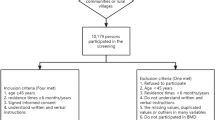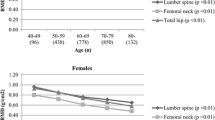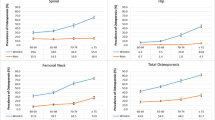Abstract
Summary
The prevalence of osteoporosis was statistically significantly higher among female Holocaust survivors than among those who were not exposed to the Holocaust. These findings support the importance of nutrition and environmental conditions during childhood and adolescence on BMD in older adults.
Introduction
Holocaust survivors during childhood and adolescence experienced undernutrition and lack of exercise and sunlight. The study aimed to establish if Holocaust survivors have higher prevalence of osteoporosis than subjects who were not Holocaust survivors.
Methods
Seventy-three female Jewish Holocaust survivors ≥ 60 years old and 60 female European-born Jews ≥60 years old who were not in the Holocaust were examined. BMD was measured using DXA of the lumbar spine and hips. The Cochran-Armitage trend test was used to test for an increasing trend in decreased BMD in the Holocaust survivors versus controls.
Results
Among Holocaust survivors 54.8% had osteoporosis, 39.7% osteopenia, and 5.5% normal BMD, whereas among controls 25.0% had osteoporosis, 55.0% osteopenia, and 20.0% normal BMD (p = 0.0001). In those who were <17 years old in 1945, among Holocaust survivors 58.0% had osteoporosis, 34.0% osteopenia, and 8.0% normal BMD, whereas among controls 20.0% had osteoporosis, 57.8% osteopenia, and 22.2% normal BMD (p = 0.0003). In those ≥17 years old in 1945, among Holocaust survivors 47.8% had osteoporosis, 52.2% osteopenia and none had normal BMD, whereas among controls 40.0% had osteoporosis, 46.7% osteopenia, and 13.3% normal BMD (p = 0.28).
Conclusion
The prevalence of osteoporosis was significantly higher among Holocaust survivors.
Similar content being viewed by others
References
Sowers MF (2000) Lower peak bone mass and its decline. Baillieres Best Pract Res Clin Endocrinol Metab 14:317–329
Javaid MK, Cooper C (2002) Prenatal and childhood influences on osteoporosis. Best Pract Res Clin Endocrinol Metab 16:349–367
Heaney RP, Abrams S, Dawson-Hughes B et al (2000) Peak bone mass. Osteoporos Int 11:985–1009
Mora S, Gilsanz V (2003) Establishment of peak bone mass. Endocrinol Metab Clin North Am 32:39–63
Saito T, Nakamura K, Okuda Y et al (2005) Weight gain in childhood and bone mass in female college students. J Bone Miner Metab 23:69–75
Cooper C, Westlake S, Harvey N et al (2006) Review: developmental origins of osteoporotic fracture. Osteoporos Int 17:337–347
Cooper C, Eriksson JG, Forsen T et al (2001) Maternal height, childhood growth and risk of hip fracture in later life: a longitudinal study. Osteoporos Int 12:623–629
Rikkonen T, Tuppurainen M, Kroger H et al (2006) Distance of walking in childhood and femoral bone density in perimenopausal women. Eur J Appl Physiol 97:509–515
Weaver CM, Peacock M, Johnston CC Jr. (1999) Adolescent nutrition in the prevention of postmenopausal osteoporosis. J Clin Endocrinol Metabol 84:1839–1843
Rizzoli R, Bonjour JP (1999) Determinants of peak bone mass and mechanisms of bone loss. Osteoporos Int 9(Suppl 2):S17–S23
Bonjour JP, Ammann P, Chevalley T et al (2001) Protein intake and bone growth. Can J Appl Physiol 26 (Suppl):S153–S166
Ho AY, Kung AW (2005) Determinants of peak bone mineral density and bone area in young women. J Bone Miner Metab 23:470–475
Pasternak A, Brooks PG (2007) The long-term effects of the Holocaust on the reproductive function of female survivors. J Minim Invasiv Gynecol 14:211–217
Beinfeld S (1998) Health care in the Vilna Ghetto. Holocaust and Genocide Studies 12:66–98
Burger GCE, Drummond JC, Sandstead HR (eds) (1948) Malnutrition and Starvation in Western Netherlands, September 1944 – July 1945. Part I. General State Printing Office, The Hague
Tushnet L (1966) The Uses of Adversity. Studies of Starvation in the Warsaw Ghetto. Thomas Yoseloff, New York
Brodsky J (2000) Background material for meeting of the Steering Committee on Holocaust Survivors. JDC Brookdale Institute of Gerontology and Human Development, Jerusalem
Werner P (2003) Self-reported prevalence and correlates of osteoporosis: results from a representative study in Israel. Arch Gerontol Geriatr 37:277–292
Foldes AJ, Brodsky J, Bentur N (2003) Long-term effects of poor environmental conditions during early life: increased prevalence of hip fractures among Holocaust survivors. J Bone Miner Res 18(Suppl 2):S53 [Abstract]
Robbins J, Hirsch C, Whitmer R et al (2001) The association of bone mineral density and depression in an older population. J Am Geriatr Soc 49:732–736
Menczel J, Gelfin Y, Shapira B (2002) Osteoporosis in patients with depression. J Bone Miner Res 17:S465 [Abstract]
Mussolino ME (2005) Depression and hip fracture risk: the NHANES I epidemiologic follow-up study. Public Health Rep 120:71–75
Kanis JA (1994) Assessment of fracture risk and its application to screening for postmenopausal osteoporosis: synopsis of a WHO report. WHO Study Group. Osteoporos Int 4:368–381
Shepherd JA, Fan B, Lu Y et al (2006) Comparison of BMD precision for Prodigy and Delphi spine and femur scans. Osteoporos Int 17:1303–1308
Keys A, Brozek J, Henschel A et al (eds) (1950) The Biology of Human Starvation. The University of Minnesota Press, Minneapolis
Winick M (ed) (1979) Hunger Disease. Studies by the Jewish Physicians in the Warsaw Ghetto. John Wiley and Sons, New York
Brooke HHW (1946) Chest-X-ray survey of repatriated prisoners of war from Japanese camps. Can Med Assoc J 54:141–144
Thygesen P, Hermann K, Willanger R (1970) Concentration camp survivors in Denmark persecution, disease, disability, compensation. A 23-year follow-up. A survey of the long-term effects of severe environmental stress. Dan Med Bull 17:65–108
Ettinger L, Strom A (1973) Mortality and Morbidity after Excessive Stress. A Follow-up Investigation of Norwegian Concentration Camp Survivors. Humanities Press, New York
Yoshimura T, Tohya T, Onoda C et al (2005) Poor nutrition in prepubertal Japanese children at the end of World War II suppressed bone development. Maturitas 52:32–34
Misra M, Klibanski A (2006) Anorexia nervosa and osteoporosis. Rev Endocr Metab Disord 7:91–99
Cooper C, Fall C, Egger P et al (1997) Growth in infancy and bone mass in later life. Ann Rheum Dis 56:17–21
Kalkwarf HJ, Khoury JC, Lanphear BP (2003) Milk intake during childhood and adolescence, adult bone density, and osteoporotic fractures in US women. Am J Clin Nutr 77:257–265
Bonjour JP, Carrie AL, Ferrari S et al (1997) Calcium-enriched foods and bone mass growth in prepubertal girls: a randomized double-blind placebo-controlled trial. J Clin Invest 99:1287–1294
Ho SC, Guldan GS, Woo J et al (2005) A prospective study of the effects of 1-year calcium-fortified soy milk supplementation on dietary calcium intake and bone health in Chinese adolescent girls aged 14 to16. Osteoporos Int 16:1907–1916
Bailey DA, McKay HA, Mirwald RL et al (1999) A six-year longitudinal study of the relationship of physical activity to bone mineral accrual in growing children. The University of Saskatchewan bone mineral accrual study. J Bone Miner Res 14:1672–1679
Ilich JZ, Skugor M, Badenhop NE et al (1997) Time since menarche is positively related to bone mass of total body and radius in premenopausal women. J Bone Miner Res 12(Suppl 1):S252 [Abstract]
Rosenthal DI, Mayo-Smith W, Hayes CW et al (1989) Age and bone mass in premenopausal women. J Bone Miner Res 4:533–538
Rubin LA, Hawker GA, Peltekova VD et al (1999) Determinants of peak bone mass: clinical and genetic analyses in a young female Canadian cohort. J Bone Miner Res 14:633–643
Castro J, Lazaro L, Pons F et al (2001) Adolescent anorexia nervosa: the catch-up effect in bone mineral density after recovery. J Am Acad Child Adolesc Psychiatry 40:1215–1221
das Neves J, Martins PA, Sesso R et al (2006) Malnourished children treated in day-hospital or outpatient clinics exhibit linear catch-up and normal body composition. J Nutr 136:648–655
Collins C, Burazeri G, Gofin J et al (2004) Health status and mortality in Holocaust survivors living in Jerusalem 40–50 years later. J Trauma Stress 17:403–411
Chrousos GP (2000) The role of stress and the hypothalamic-pituitary-adrenal axis in the pathogenesis of the metabolic syndrome: neuro-endocrine and target tissue-related causes. Int J Obes Relat Metab Disord 24(Suppl 2):S50–S55
Bachar E, Canetti L, Berry EM (2005) Lack of long-lasting consequences of starvation on eating pathology in Jewish Holocaust survivors of Nazi concentration camps. J Abnorm Psychol 114:165–169
Author information
Authors and Affiliations
Corresponding author
Rights and permissions
About this article
Cite this article
Marcus, EL., Menczel, J. Higher prevalence of osteoporosis among female Holocaust survivors. Osteoporos Int 18, 1501–1506 (2007). https://doi.org/10.1007/s00198-007-0389-x
Received:
Accepted:
Published:
Issue Date:
DOI: https://doi.org/10.1007/s00198-007-0389-x




